Things to Try with AAC Learners who Have Short Attention Spans
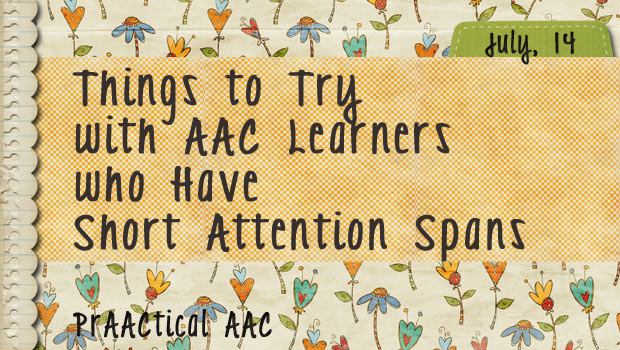
We love talking to AAC practitioners, hearing their stories, and picking up some tips along the way. Some conversations we love for the creative ideas or underlying passion. Others are memorable for less positive reasons. But still, they give us pause and challenge us to be better problem-solvers.
“I love those ideas, but they won’t work with MY client: He doesn’t pay attention. He’s just not ready for all this. How do you expect me to teach someone with such a short attention span?”
Glad you asked!
First, don’t blame the learner. Like having short legs or frizzy hair, attention span is something over which some learners have little or no control. Their physiology is their physiology and they may not like it any more than we do.
Use high-interest components in your therapy. The goals are the goals, but we can use things the client likes to make working on them more interesting. Add a Sponge Bob or Hello Kitty pointer to a challenging reading activity to make it more palatable.
Over-prepare. Come prepared with a million activities to meet the target objectives. Okay, maybe not quite a million, but a lot more that you think you would ever need. When you can see enthusiasm for an activity starting to wane, move to end the activity (under YOUR terms, of course), then go on to something else. “Jason, you might be tired of ___. Two more and then we’re done.”
Plan for short, engaging activities. Work quickly. If we know the client has a limited attention span, why not incorporate that in our planning? Short, successful activities are better than longer, frustrating ones. Besides, there are a LOT of ways to work on the same target skill. Go with what works. Teaching the skill in 3-4 mini brief activities may be more effective than doing it in one, longer activity (and that’s good for generalization, too).
Make the expectations clear. Design activities in such a way so as to make it apparent to the learner how much 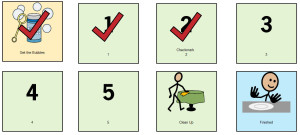 they have to do or how long the activity lasts. How? With visual supports, such as a countdown board, or by using the actual materials. If we’re doing a puzzle or Mr. Potato Head, it’s easy because we have a set number of pieces to put in. But what if it is bubbles or an art activity? Consider using a mini-schedule or visual support for that activity that specifies how many or how long it will last.
they have to do or how long the activity lasts. How? With visual supports, such as a countdown board, or by using the actual materials. If we’re doing a puzzle or Mr. Potato Head, it’s easy because we have a set number of pieces to put in. But what if it is bubbles or an art activity? Consider using a mini-schedule or visual support for that activity that specifies how many or how long it will last.
Alternate types of activities. Easy, hard, easy. Sitting, moving, sitting. Really fun, less fun, really fun. Adult-led, child-directed, adult led.
Change the environment, if possible, as a short-term strategy. Minimize distractions, then gradually add them back in. Can you move to a quieter therapy room? Probably not, but if you can, give it a try. Make the environment as distraction-free as possible and then add those distractors back in as they get accustomed to working in a progressively noisier environment. One second grader I worked with who could hardly pay attention for a minute, got to the point where we could do an hour session with the door open with minimal loss of focus. We rarely have enough control over the learning environment to pull this off, but when that IS possible, take advantage of it.
Therapy is certainly easier when your client has a decent attention span but it’s not a pre-requisite for AAC intervention. Good SLPs teach the learners they have, not the ones they wish for.
Do you have favorite ways of supporting AAC learners with limited attention spans? We’d love to hear about them.
Filed under: PrAACtical Thinking
Tagged With: attention span, intervention
This post was written by Carole Zangari

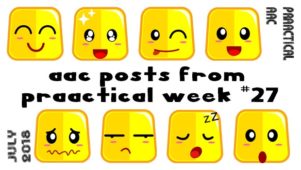
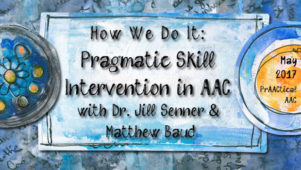
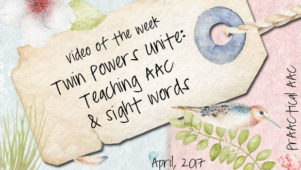

1 Comment
I use a countdown timer. The numbers 1-5 are placed in descending order on a verticle board. I put a symbol for a reward at the bottom. I pull off the numbers periodically so the student can see when the activity will be over. We also use color coding from the Incredible Five Point Scale with red for the 5 and green for 1. I also use a mini schedule and include very quick yet fun iPad apps. The student can take a break and play one level of a game such as Angry Birds or Temple Run. They are short breaks and just enough motivation to keep going. The only problem is some kids rush too quickly to get to the activity.